- Missionary-9
- Missionary-15
- Missionary-13
- Missionary-7
- Missionary-8
- Missionary-6
- Missionary-5
- Missionary-3
- Missionary-11
- Missionary-12
- Missionary-10
- Missionary-17
| Temple Square is always beautiful in the springtime. Gardeners work to prepare the ground for General Conference. © 2012 Intellectual Reserve, Inc. All rights reserved. | 1 / 2 |
This story appears here courtesy of TheChurchNews.com. It is not for use by other media.
By Rachel Sterzer Gibson, Church News
As Sister Abby Jefferies prepared to return to the Nauvoo Illinois Historic Site as a full-time missionary last summer, she was faced with many unanswered questions. When she had served there the summer of 2019, the small city steeped in Church history had attracted throngs of people. In 2020, however, the usually vibrant site, which is nestled in a curve of the Mississippi River, was desolate. COVID-19 had closed the site to visitors.
“I remember wondering to myself, ‘What is my purpose in being here right now if we’re not being able to share the message like we did the previous summer, when people would come all the time? Why am I here?’” recalled Sister Jefferies, who has since returned from her mission.
After serving for eight months in the Tennessee Knoxville Mission as a proselyting missionary, she wondered how she would fill her days in Nauvoo. The previous summer had provided ample opportunity for her to share her testimony of the Restoration. This year, however, there would be no in-person guided tours of the historic buildings, no demonstrations of authentic trades and no Nauvoo Pageant.
Her predicament was one faced by missionaries and Church history sites across the country as the spread of the coronavirus continued to disrupt the normal operations of schools, businesses, organizations, churches and individuals.
However, through “lots of miracles” and the help of technology, Sister Jefferies and the many other missionaries serving at Church history sites have not only continued to share the message of the Restoration, but have also increased its reach.
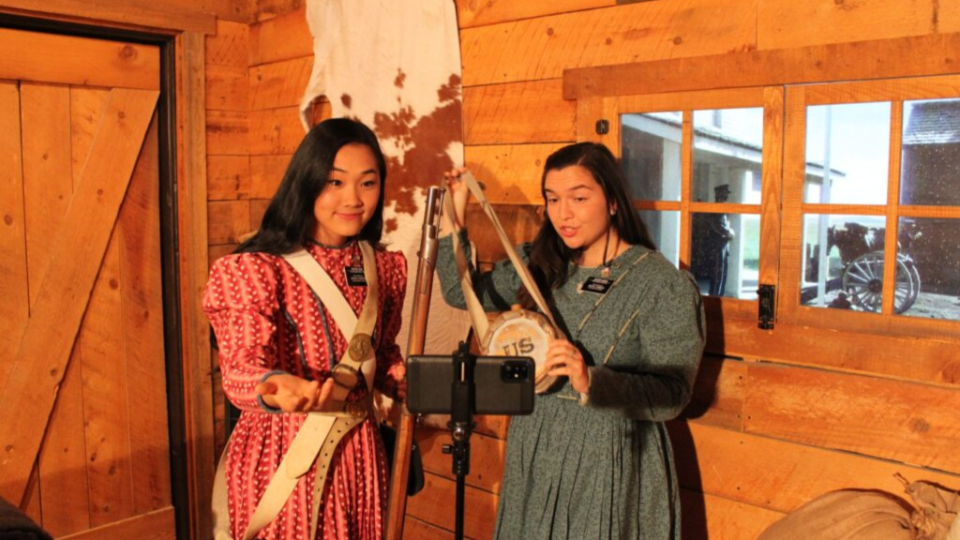
Missionary-14
Sister Sarah Sun and Sister Pamela Wach showcase authentic clothing during a virtual tour of the Mormon Battalion Historic Site. Because of COVID-19, Church historic sites have been closed to in-person visitors since March 2020. Credit: Courtesy the Nauvoo Historic Sites, courtesy Church NewsAll rights reserved.The Power of Place
Even though the Church’s many historic sites are all found within the United States, they have significance to members of the Church globally, explained Gary Boatright, operations manager of historic sites for the Church History Department.
Boatright recalled taking his family to the New York historic sites where they could see for themselves the Joseph Smith Family Farm, the Sacred Grove and the Hill Cumorah. His daughter turned to him at one point and said, “Dad, I get it. I get it.” Seeing and experiencing the sites helped her connect with the people and stories she had learned about.
“There is power about place,” Boatright said.
The purpose of any tour of a historic site — from the Sacred Grove and Hill Cumorah in Palmyra, New York, to the Mormon Battalion Historic Site in San Diego, California — is to provide an understanding of the significance and sacredness of the place and to invite the Spirit to testify that what happened in these places is real, added Benjamin Pykles, Church historic sites curator. “That’s why we want to share them with the world.”
This desire to share the historic sites created a quandary in 2020. In March 2020, the Church announced that as a precaution to the COVID-19 pandemic, Church history sites were closed. Many senior missionary couples, who make up much of the support staff at the sites but were most at-risk to the virus, were sent home. Young international sister missionaries were reassigned to their home countries.
As the site closed, Mormon Battalion Historic Site President C. Bradford Allen said they wondered, “Oh my goodness, what are we going to do? We’ve got to really change our course of direction here on how we serve.”
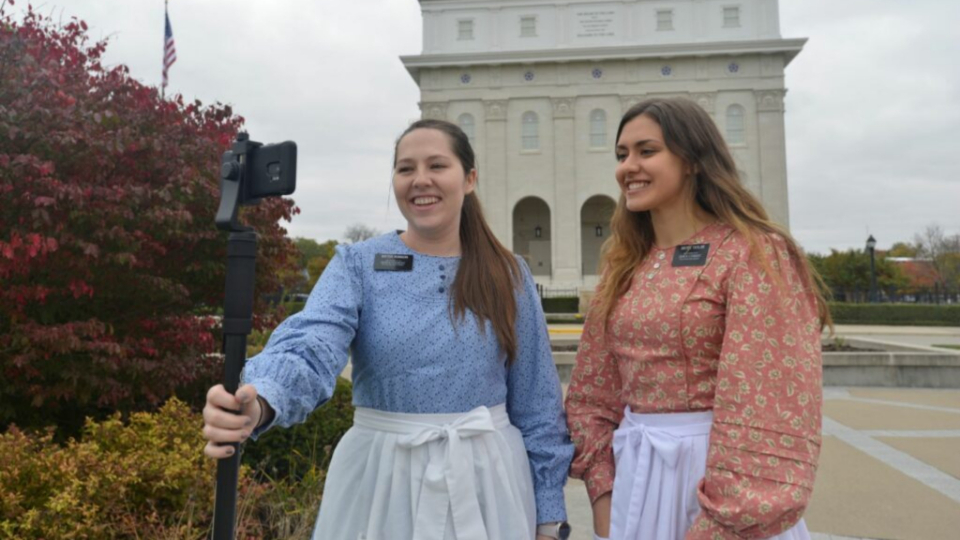
Missionary-2.jpg
Sister Shaylee Dye and Sister Gabrielle Iverson conduct a virtual tour of Grandin Building at the Book of Mormon Publication Site. Missionaries are conducting virtual tours of historic sites since their closure to visitors in March 2020 due to COVID-19 pandemic. Credit: Courtesy New York and Pennsylvania Historic Sites, courtesy Church NewsAll rights reserved.At the New York and Pennsylvania Historic Sites, President Terry J. Spallino wondered the same thing. “We didn’t know if there was going to be anything to do, or if we were going to be going home,” he recalled.
The sister missionaries at the sites started praying about what they could do, President Spallino said, and soon began experimenting at giving simple tours on their phones to family and friends.
In San Diego, President Allen heard about some of the other historic sites exploring the idea of video tours and thought, “We can do that.”
Soon missionaries at many of the Church sites started offering virtual tours to their friends and family and began using social media to reach out to others.
With the help of sister missionaries adept at social media, news of the virtual tours “spread like wildfire around the world,” Boatright said.
For example, in response to President Russell M. Nelson’s April 4 invitation to the world to fast for relief from the COVID-19 pandemic, a Facebook group was created. More than 500,000 joined the group in the first day. Eventually, a sister missionary posted to the group about the opportunity to take a virtual tour of a historic site. Soon, thousands of people were messaging about wanting to take a virtual tour.
An Organic Process
Getting started with the tours required some experimentation. At the Mormon Battalion Site, President Allen bought a tripod and “we just started figuring it out.”
There were a lot of bugs to work out, Sister Jefferies recalled of the first virtual tours she gave. Sometimes there were technology glitches, and as demand increased, scheduling became more complicated.
Boatright said he heard from many site leaders that the missionaries — both the young sisters and the seniors who were serving at their sides during this time — were the right people at the right time. “They just came with the skills, they came with the understanding, they came with the enthusiasm, and for me it is a testimony again reconfirming that the Lord is in charge,” Boatright said.
For example, President Allen’s wife, Sister Dantzelle L. Allen, said they were blessed with four new missionaries who arrived at the right time with the technical skills and interests to be able to run with it.
“It’s been wonderful to see how the Lord has guided our efforts,” she said.
The Nauvoo sites were blessed in a similar way, President J. Stephen Rizley, president of the Nauvoo Historic Sites, added. One sister missionary had the skills to build a scheduling database when their scheduling needs soon outgrew a simple spreadsheet. Amongst their senior missionaries was a retired videographer editor. “So we had a brother here, who in addition to being a site missionary, actually had professional skills that lent themselves to the training that we would do to begin to conduct these,” President Rizley said.
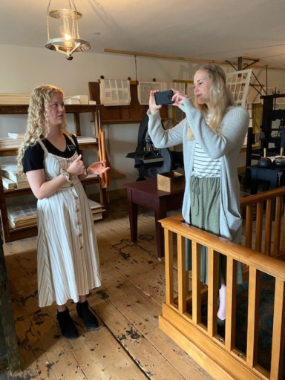
Missionary-4
Sister Shaylee Dye and Sister Gabrielle Iverson conduct a virtual tour of Grandin Building at the Book of Mormon Publication Site. Missionaries are conducting virtual tours of historic sites since their closure to visitors in March 2020 due to COVID-19 pandemic. Credit: Courtesy New York and Pennsylvania Historic Sites, courtesy Church NewsAll rights reserved.Even though they make mistakes, the missionaries are great innovators, President Spallino said.
In the New York and Pennsylvania Historic Sites where missionaries walk between homes and through corn fields, cellular service and WiFi sometimes cuts in and out or isn’t strong enough to stream video. One sister missionary put together a slide presentation with photos she can share and speak over when the WiFi dips.
Accommodating time zones has required some early mornings and late nights for some of the tours, President Rizley noted. “But with our missionaries, there’s a great appetite on their part to do this, and we are able to set schedules in place that allow us to accommodate it.”
The live-video tours are “fun, interactive, educational and spiritual,” President Allen said and, despite failures and rough spots, President Spallino said, “it’s been a great learning experience. The Lord has been patient with us, but He expects us to improve. [The tours] are just going to get better and better.”
The biggest challenge, President Rizley said, has been having the faith that the Holy Ghost will testify through a little phone on a monopod.
That was something Sister Jefferies said she and her companion were nervous about the first time they gave a tour over Zoom. “We felt like we were brand new missionaries all over again. It felt like we didn’t really know what we were doing.”
However, even though they were using technology and weren’t looking people in the eyes, and although there were blunders and mistakes, “we could still really feel the Spirit,” Sister Jefferies said.
Whether a person can experience the historic sites in person or virtually, “the Spirit can transcend technology and space and time and testify to someone who’s sitting in the Philippines watching the missionaries give a tour just as powerfully as they can to someone who’s standing in the Sacred Grove,” Boatright said.
A Global Impact
Early in the pandemic, an institute director in Quito, Ecuador, who wanted his students to be able to experience Church history, reached out asking if it was possible for them to take a video tour of Carthage Jail, recalled President Rizley. That tour, conducted over FaceTime, ended up being the site’s first virtual tour.
Since then, the Nauvoo Historic Sites have hosted tours to both members and non-members in almost every state in the United States and to countries as far-flung as Mauritania, Zambia, Suriname and the United Arab Emirates.
Just recently, President Allen said, the sister missionaries at the Mormon Battalion Site conducted a tour that included individuals from five different countries. President Spallino has seen groups numbering in the thousands as stakes in the United States and South America have organized tours.
Pykles said that before virtual tours, less than 1% of the Church membership would be able to visit many of these sites. Even if the sites this year are not necessarily getting more visitors with the virtual tours, “we’re certainly hitting people that have never been able to experience these places in any way or in any fashion before,” he said.
President Spallino shared the experience of a family from Saudi Arabia who took a virtual tour of the Smith Farm and Sacred Grove. After the tour, they knelt in front of the computer screen and expressed their gratitude. They said they were very sure that they would never be able to come to Palmyra in person and were grateful to be able to “see” and “feel” it via technology.
“People often say, ‘We can feel the Spirit there,’” said Sister Linda J. Spallino, the president’s companion of the New York and Pennsylvania Historic Sites. “The Lord is a great organizer of good things.”
“When you think about what we were planning for 2020 to be like and what it’s turned out to be, in a real sense, we have a much more successful year this year in getting the story of these sacred places to the world,” Boatright said.
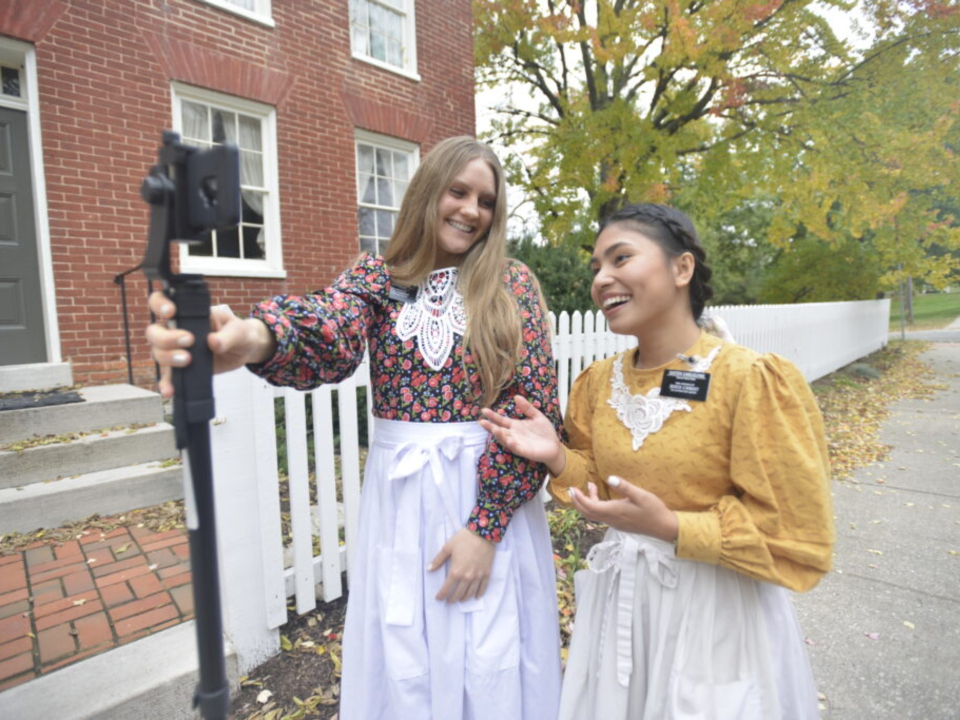
Missionary-1
Sister Daicee Smuin and Sister Sheila Cabuquing, missionaries serving at the Nauvoo Historic Sites, stop to show virtual visitors the Wilford Woodruff home in Nauvoo. Because of COVID-19, Church historic sites have been closed to in-person visitors since March 2020. Credit: Courtesy the Nauvoo Historic Sites, courtesy Church NewsAll rights reserved.For Sister Jefferies, the virtual tours provided an opportunity to share her testimony of the Restoration, not only in a global way as she taught people from Cambodia, Zimbabwe and France, but also in a personal way as she taught her own family and friends.
“I saw miracles even within my own family,” Sister Jefferies said. “People who were struggling with their testimonies texted me or emailed me after the tours and just told me that they felt the Spirit in a way that they haven’t ever had before, and I just felt so grateful that I could share my mission. I’m just really grateful that I had those opportunities for the personal impact and also for the global impact.”
Going Forward
Pykles said they’ve learned a lot this year, but they still have a lot of work to do in continuing to reach their global audience. A prerecorded tour might have a role to play in areas of the world that will never have normal waking hours when the Sacred Grove has normal daylight hours. The historic sites also have limitations on the languages in which they can offer a live tour. The Cove Fort Historic Site in Utah and the Mormon Trails Site in Wyoming are unable to provide virtual tours right now because of connection issues.
Someday, he said, they hope to have a suite of recorded segments or thematic tours that can be linked to curriculum, such as this year’s study of the Doctrine and Covenants. “There’s so much potential here. We’re just scratching the surface, and we’re excited to keep working towards those goals,” Pykles said.
Looking back, Sister Jefferies acknowledges that her worries in returning to Nauvoo were shortsighted. On her last Sunday in the mission field, she and her companion had virtual tours lined up for the entire day, including a tour for one of her recent converts from Tennessee. “I just remember thinking, ‘This is the fruits of my labors here.’” Whether she was providing an in-person tour or a virtual tour, her purpose was the same. “The work of the Lord is the same everywhere. Just the way that we execute that work has to change because of our circumstances.”
These new virtual tours aren’t just something to keep everyone busy during the pandemic, President Rizley said. “We’re fulfilling our missionary purpose here. We’re fulfilling our callings.”
To schedule a tour: The link to schedule a virtual tour can be found on each site’s individual Facebook page or simply click the name of the site you would like to schedule with below.
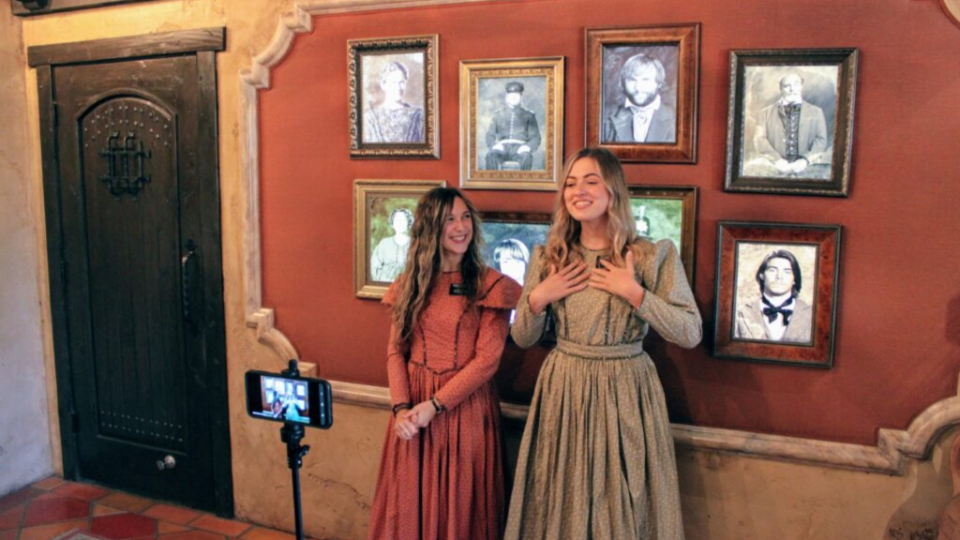
Missionary-16.jpg
Sister Jessa Lethbridge and Sister Hannah Van Holten welcome virtual visitors to the Mormon Battalion Historic Site in San Diego, California. Credit: Mormon Battalion Historic Site, courtesy Church NewsAll rights reserved.Here’s a list of Church historic sites currently offering virtual tours:
Joseph Smith Birthplace, Sharon, Vermont
Tours last about 50 minutes
New York and Pennsylvania Sites (includes the Sacred Grove and Smith Farm, Book of Mormon Publication Site and Priesthood Restoration Site)
Tours last about 40 minutes
Also available in Spanish
Kirtland Area Historic Sites (includes the Historic Kirkland Sites and Historic Johnson Farm)
Tours last 30 to 60 minutes
Historic Nauvoo and Carthage Jail (includes Nauvoo Temple City, Homes of the Apostles, Frontier Life, Women of Nauvoo, Pioneer Trades and Carthage Jail)
Tours are 15–20 minutes
Conducted in English with a limited number of tours offered in Spanish and Portuguese
Missouri Area Historic Sites (includes the Independence Visitors’ Center)
Tours last about 30 minutes
Liberty Jail
Tours take about 30 minutes
Mormon Trail Center at Winter Quarters
Tours take about 30 minutes
Handcart sites
Not providing virtual tours at this time
Cove Fort, Utah
Not providing virtual tours at this time
St. George Area Historic Sites
Tours take 30 to 40 minutes
Mormon Battalion Historic Site
Tours last about 45 minutes
Available in English, Spanish and Chinese
Copyright 2020 Deseret News Publishing Company